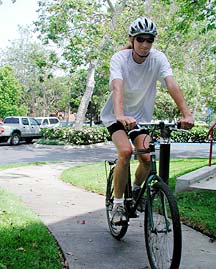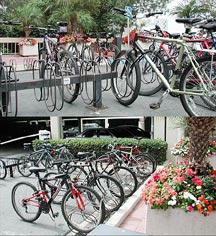My Other Car is a Bike:
TSRI Employees Reap Benefits of Two-Wheel Commuting
By Jennifer O'Sullivan
At present writing, Lance Armstrong is poised to win his fifth straight
Tour de France, the final stage of which culminates with a breakaway through
the streets of Paris and the "lap of honor" down the Champs Elysées
lined with throngs of cheering cycling aficionados. (Bicycling
magazine jests that the principal difficulty of this final stage is dodging
champagne corks.)
There is certainly no other bike ride like le Tour, and no such
fanfare awaits employees of The Scripps Research Institute (TSRI) who
commute to work by bike. However, judging from the enthusiasm of those
who do ride, the last leg to the office or lab can indeed seem like a
victory lap.
Kathleen Keehan, executive director of the San Diego County Bicycle
Coalition (SDCBC), recently spoke at TSRI on "Smart Cycling" as part of
the ongoing Lunch & Learn seminar series. The talk—which drew an
audience of TSRI employees who already cycled to work and those who were
interested in starting—focused on the "big questions," namely the
reasons to cycle and how to do it safely.
Einstein and the Environment
People who commute to work by bike do so for a variety of reasons, which
Keehan classified into two groups, personal and environmental.
Personal reasons for cycling can include saving money on gas, avoiding
traffic, and, in cases where the car is eliminated completely, saving
on the cost of buying, insuring, and maintaining an automobile. Physical
fitness is, of course, high on the list of reasons to bike. Interestingly,
TSRI cyclists often list the mental benefits of cycling as well, recalling
Albert Einstein's quote that he came up with the theory of relativity
while riding his bike.
Research Computing's Senior Applications Specialist Christoph Weber,
who is a member of SDCBC and who was a moving force behind Keehan's talk
at TSRI, commutes daily from University City on his bike, 12 miles round
trip. "I arrive in the morning and back home in the evening relaxed and
with a clear mind," he says. "I sorely miss this on the few days when
I drive my car to work."
Cyclist-commuter Ben Pratt, a first-year graduate student in the Nicolaou
lab who rides five miles, four to five times a week, echoes this sentiment,
observing that he is totally awake when he gets to work—"without
coffee." Brian Bothner, a research associate in Jack Johnson's lab who
cycles his 30-mile round-trip commute two to three times a week, describes
the bicycle commute as "a workout/meditation session that keeps me focused
and relaxed."
Indeed, the commute can serve as a primary form of exercise. "You can
get in a workout to and from work," notes Jann Coury, web producer and
publications specialist in TSRI's Office of Communications. "I live about
16 miles from TSRI, a little over an hour's bike ride each way. On the
way home, the length of the bicycle commute is only about 15 minutes longer
than the drive. Such a deal! By the time I get home, I'm done working
out and ready for dinner."
Environmental considerations, such as lessening the amount of air and
noise pollution, easing the demand for parking, minimizing traffic, and
curbing dependence on oil, are also important to many. Bothner asserts,
"Bicycles are the most efficient way for humans to travel, and, other
than the manufacturing process, they're non-polluting."
Bryan Clarkson, a research tech in the Wright lab, agrees. "I am a big
supporter of alternate forms of transportation, my favorite of which is
the bicycle... I've slowly been finding more and more people in San Diego
who share this view, which is cool considering how car-oriented the city
is."
A final reason for cycling, Keehan points out, is one that's often missed.
"People forget that it's fun to tool around on a bike."
It's All Fun and Games 'Til Someone Breaks a Collarbone
"A good cyclist does not need a high road," Arthur Conan Doyle once
wrote. Regardless of the road traveled, cyclists take on the responsibilities
of riding safely. According to Keehan, most urban bike crashes involving
an injury are the result of a "single vehicle" collision, for example
crashing as a result of riding through a slick patch of road. The SDCBC
also contends that 18 percent of bike crashes involve a car, and half
of those incidents are determined to be the car driver's fault.
As part of the group's efforts to promote safe bicycle riding, the SDCBD
recommends adhering to the following basic rules:
- Use the right equipment, and make sure it's in good working order.
(An extra tube or patch kit, tire tools, and a bike pump are considered
necessary accessories for the road.)
- Wear a helmet, and make sure it fits properly.
- Follow the rules of the road—ride predictably.
- Be visible, especially if you ride after dark.
- Don't ride impaired by drugs or alcohol.
In general, experts agree that bicyclists fare best when they act and
are treated as drivers of vehicles. The problem is not all drivers act
alike, nor do all cyclists. And those who don't act appropriately—in
other words cyclists who don't obey traffic signs and signals, and drivers
who don't watch closely and make room for cyclists—make it difficult
for those who do. The result is a continually tested and sometimes strained
relationship between the two groups, however the bicycle coalition stresses
the cyclists' responsibility in helping to maintain the safety of everyone
on the road.
"It gives the bicyclists a black eye in the community when people on
bikes don't obey traffic signs," Keehan cautions, and recommends that
novice cyclists take the SDCBC's "Bike Ed" training program, which teaches
people to be comfortable riding in traffic. For those who do know the
rules of the road, Weber's advice is to "ride with confidence and be assertive,
but not aggressive."
To Shower or Not to Shower (That is the Question Your Coworkers Can
Answer)
Along with traffic obstacles are other practical considerations of commuting
to work by bike—the early rise, the flat tires resulting from potholes
and debris, traffic signals that aren't triggered by a bike alone, the
weather (tame in San Diego compared to most parts, but still a factor),
and time constraints, especially in the winter for those who don't wish
to ride in the dark.
In the interest of time management, some commuters choose a public transit–bike
combination to get to work. Clarkson, who was a bike messenger in Los
Angeles just before coming to work at TSRI, cycles daily from his house
near SDSU to downtown San Diego, about seven or eight miles. He then takes
a city bus to UCSD and rides to TSRI from there, making the total distance
on his bike about nine miles one way. "It takes me about one and a half
hours from the time I leave my house to the time I'm showered and in the
lab," Clarkson reports. "It probably could be a little shorter, but I
usually leave my house early just in case I flat out on the way to the
bus."
Once cyclists arrive at TSRI, more considerations await—namely,
storing the bike and bathing the bod.
The majority of TSRI employees who bike to work lock their mode of transport
to a bike rack or railing near their lab building. Most buildings on campus
have bike racks nearby, and installation of a rack at the CarrAmerica
(CIMBIO) facility is scheduled for August. Alternatively, if space is
available, some employees store a bicycle in the lab or office.
"As long as it's not impeding anyone's work or posing a hazard it's
okay," says Ben Morris, vice president of Facilities Services. Morris
stresses, however, that because stairwells must be kept clear for emergencies,
no bike storage is permitted in campus stairwells.
One major plus for TSRI bicycle-commuters is that many buildings on
campus have shower facilities. Immunology, Stein, MB (which does require
a code to enter), CVN, ICND, MEM, and CarrB all have locker rooms with
showers and are typically stocked with towels. The administrative manager
of the department occupying the building often assigns the lockers.
Given the traffic in the locker rooms and the number of bikes one sees
locked to the various racks around campus, there seem to be a fair number
of TSRI employees who are biking to work.
The SDCBC estimates that two to four percent of the commuters on the
road on any given day are riding a bicycle. When asked, most TSRI bicycle-commuters
indicate that they cycle both to and from work at least three times a
week. Many do so daily. Those with a longer commute (15 to 30 miles round-trip)
appear to ride slightly fewer days than those whose commute is between
four and eight miles.
"I have only four and a half to five miles to work so it feels stupid
to get into a car for that short distance," says Research Associate Per
Bengtson, who either runs or rides to the MEM building four times a week.
"Where I come from, Sweden, most people bike to work or school, even during
the snowy winter. But I guess that the main reason I bike to work is for
fitness and environmental issues. Since I live in Del Mar it is actually
faster for me to get home during rush hours by bike than by car. In the
downhill on North Torrey Pines Road along Torrey Pines State Reserve there
is usually a long line of cars with one person in each car. I just put
on a big smile as I pass."
Vera Tai, a research assistant in the Ginsberg lab, is also smiling—"Biking
is great," she says, "especially in the fabulous San Diego weather during
rush hour!"
So, what are you waiting for? For more information on cycling in San
Diego visit these websites:
The San Diego County Bicycle Coaltion
RideLink, sponsored by the San Diego
Association of Governments (SANDAG)
Go back to News & Views Index
|

Senior Applications Specialist Christoph Weber saves
the cost of an additional car by biking to work. Photo
by Kevin Fung.

TSRI cyclists sail by rush hour traffic on Gilman
Drive. Photo by Jennifer O'Sullivan.

Many TSRI cyclists store their bikes on the racks
and railing near the Immunology building. Photo by Jennifer
O'Sullivan.
|



